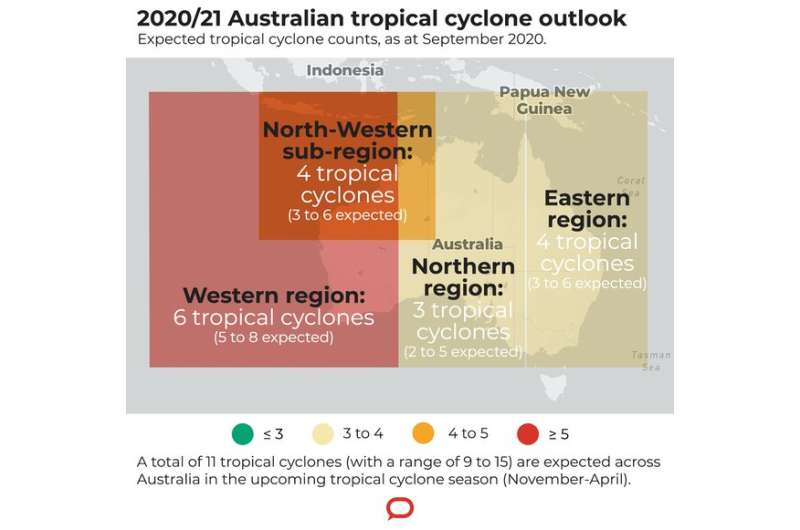New model shows Australia can expect 11 tropical cyclones this season

Tropical cyclones are considered one of the most . But they're erratic—where, when and how many tropical cyclones form each year is , which makes them difficult to predict.
In our published today, we created a statistical model that predicts the number of tropical cyclones up to four months before the start of the tropical cyclone season from November to April.
The model, the , indicates normal to above normal tropical cyclone activity with 11 cyclones expected in total, Australia-wide. Though not all make landfall.
This is above Australia's average of , thanks to a climate phenomenon brewing in the Pacific that brings closer to Australia.
La Niña and tropical cyclones
As we've seen most recently with Tropical Storm , tropical cyclones can cause over vast areas. This includes extreme and damaging winds, , , large waves and .
Australian tropical cyclone behavior is largely driven by the El Niño-Southern Oscillation (ENSO)—a global that changes ocean and atmospheric circulation.
"La Niña" is one phase of ENSO. It's higher than normal tropical cyclone numbers in the Australian region. And the Bureau of Meteorology's indicates there's a this year.
Around occur in the Australian region every season, and about four of those usually make landfall.
Historically, La Niña has resulted in in Australia, compared to phases. An "El Niño" event is associated with warmer and drier conditions for eastern Australia.
During La Niña events, the first tropical cyclone to make landfall also tends to occur . In fact, in Queensland, the only tropical cyclone seasons with multiple severe tropical cyclone landfalls have been .
Severe , one of the most intense tropical cyclones to have hit Queensland, occurred during a La Niña in 2011. So did the infamous Severe , which made landfall around Darwin in 1974, and leaving more than 80% of all buildings destroyed or damaged.
While naturally occurring climate drivers, such as La Niña, influence the characteristics of tropical cyclone activity, climate change is also expected to cause changes to , including frequency and intensity.
Australian tropical cyclone outlooks
Tropical cyclone outlooks provide important information about how many tropical cyclones may pass within the Australian region and subregions, before the start of the cyclone season. Decision-makers, government, industry and people living in tropical cyclone regions use them to prepare for the coming cyclone season.
The Australian Bureau of Meteorology has led the way in producing , usually a couple of weeks before the official start of the tropical cyclone season.
But with monthly guidance up to four months before the start of the season, our new model, , is unmatched in lead time. It considers the most recent changes in ENSO and other climate drivers to predict how many tropical cyclones may occur in Australia and its sub-regions.
As a statistical model, is trained on historical relationships between ocean-atmosphere processes and the number of tropical cyclones per season.
For each region, hundreds of potential model combinations are tested, and the one that performs best in predicting historical tropical cyclone counts is selected to make the prediction for the coming season.
So what can we expect this season?
September's TCO-AU guidance suggests for Australia for the coming tropical cyclone season (November 2020—April 2021).
With an and sea surface temperatures in the eastern Indian Ocean, 11 tropical cyclones are expected for Australia. There's a 47% chance of 12 or more cyclones, and a probable range of between nine and 15.
For the Australian sub-regions, TCO-AU suggests the following:
- above normal activity is expected for the Eastern region (eastern Australia) with four cyclones expected. Probable range between three and six cyclones; with a 55% chance of four or more cyclones
- normal activity is expected for the Western region (west/northwest Western Australia) with six cyclones expected. Probable range between five and eight cyclones; 39% chance of seven or more cyclones
- below normal activity is expected for the Northern region (northwest Queensland and Northern Territory) with three cyclones expected. Probable range between two and five cyclones; 37% chance of four cyclones or more
- below normal activity is also expected for the Northwestern region (northwest Western Australia) with four cyclones expected. Probable range between three and six cyclones; 45% chance of five cyclones or more.
Guidance from does not and should not replace advice provided by the Australian Bureau of Meteorology. Instead, it should be used to provide a complementary perspective to regional outlooks and provide a "heads-up" in the months leading up to the start of and within the cyclone season.
Regardless of what's expected for the coming cyclone season, people living in tropical cyclone regions should always and follow the advice provided by emergency services.
Provided by The Conversation
This article is republished from under a Creative Commons license. Read the .![]()





















